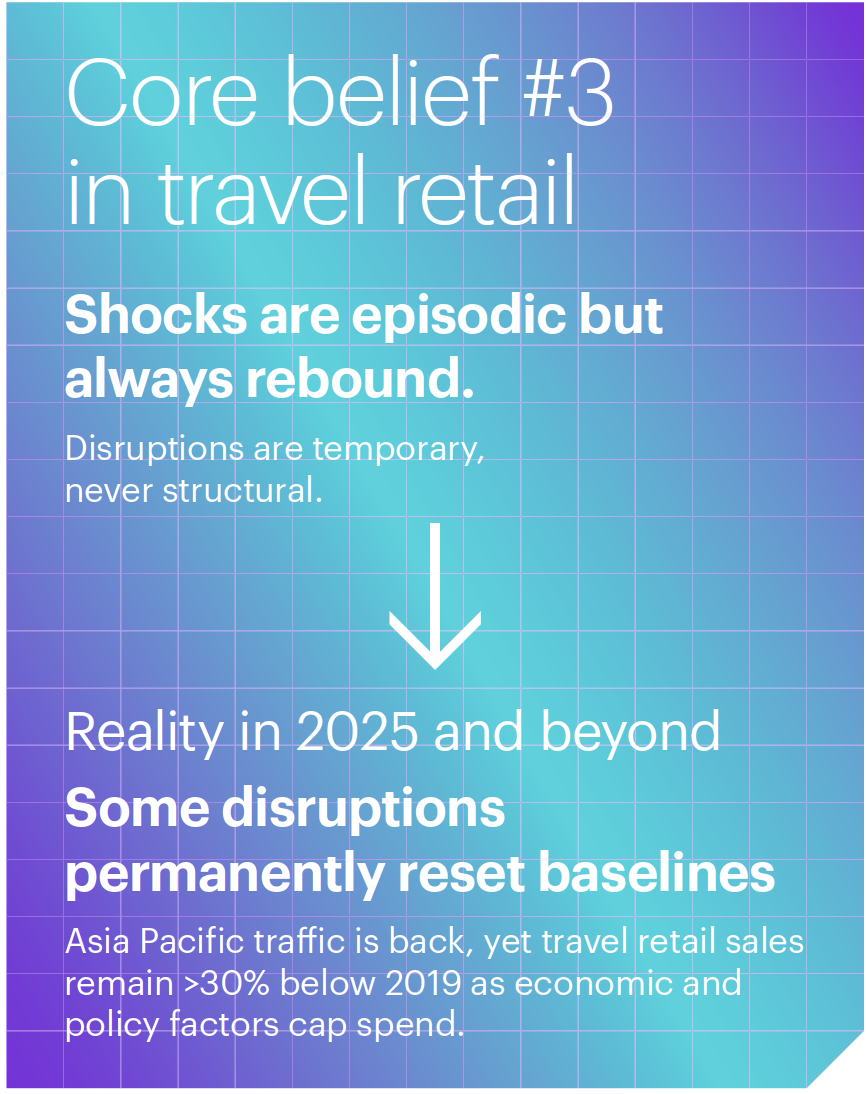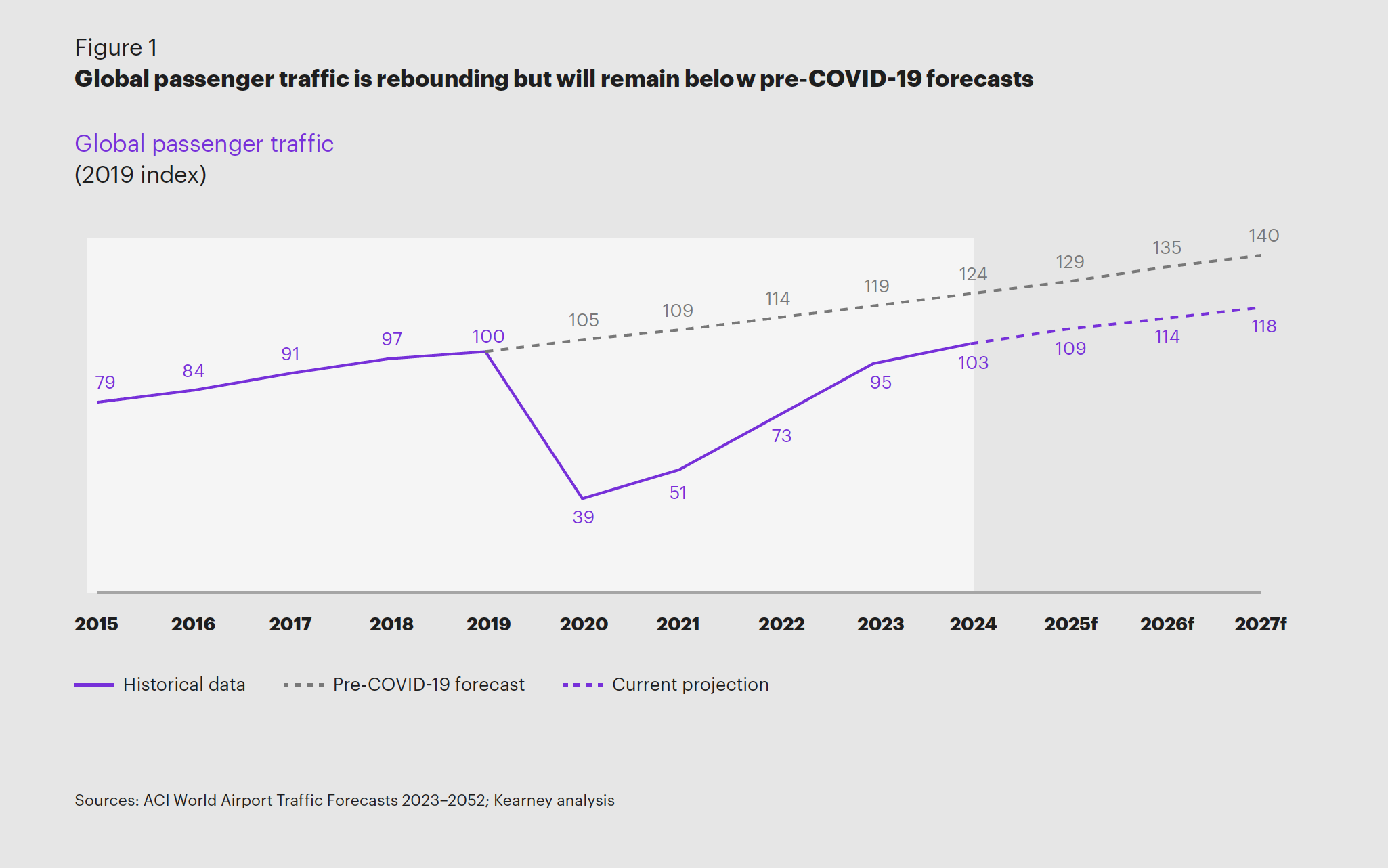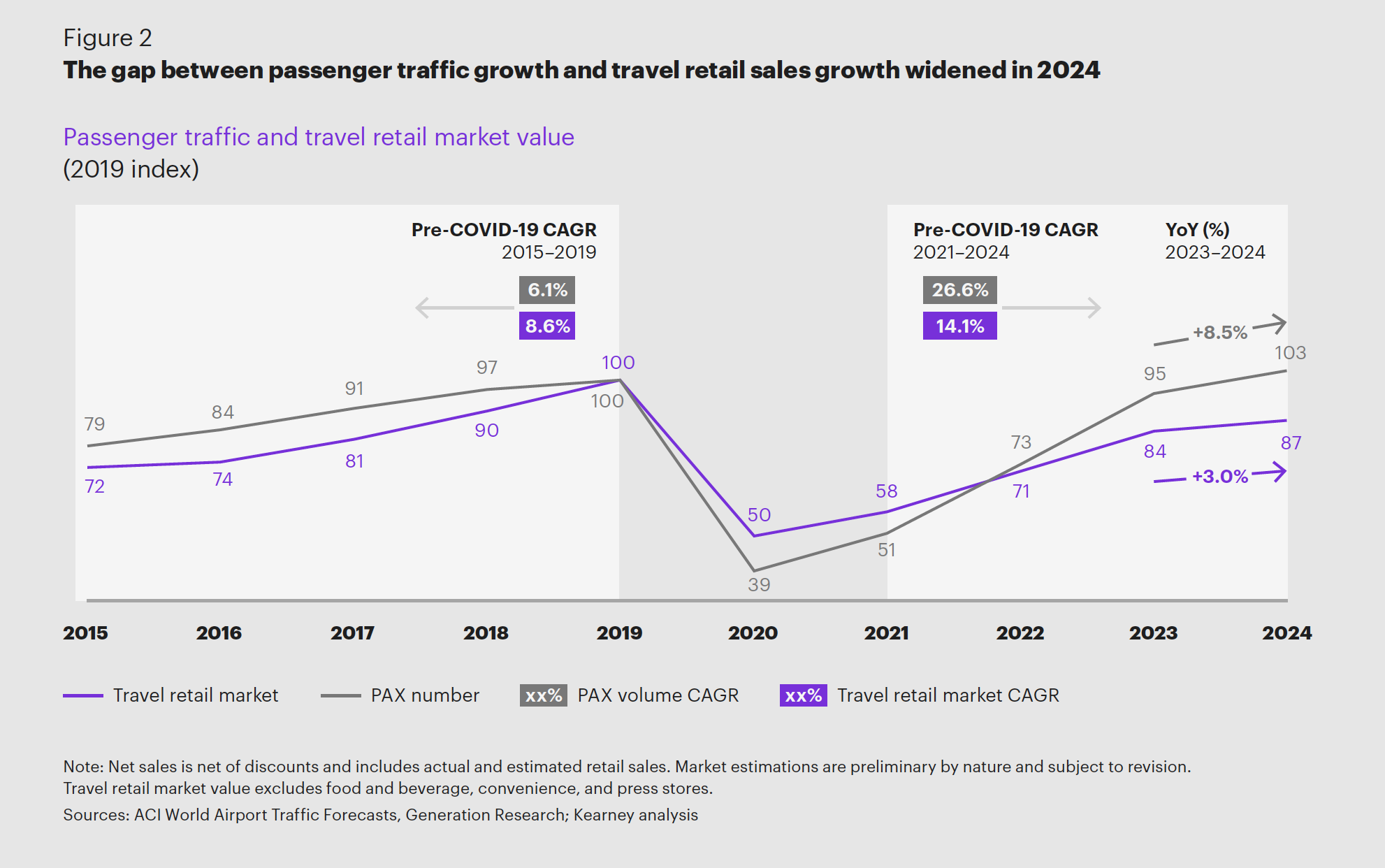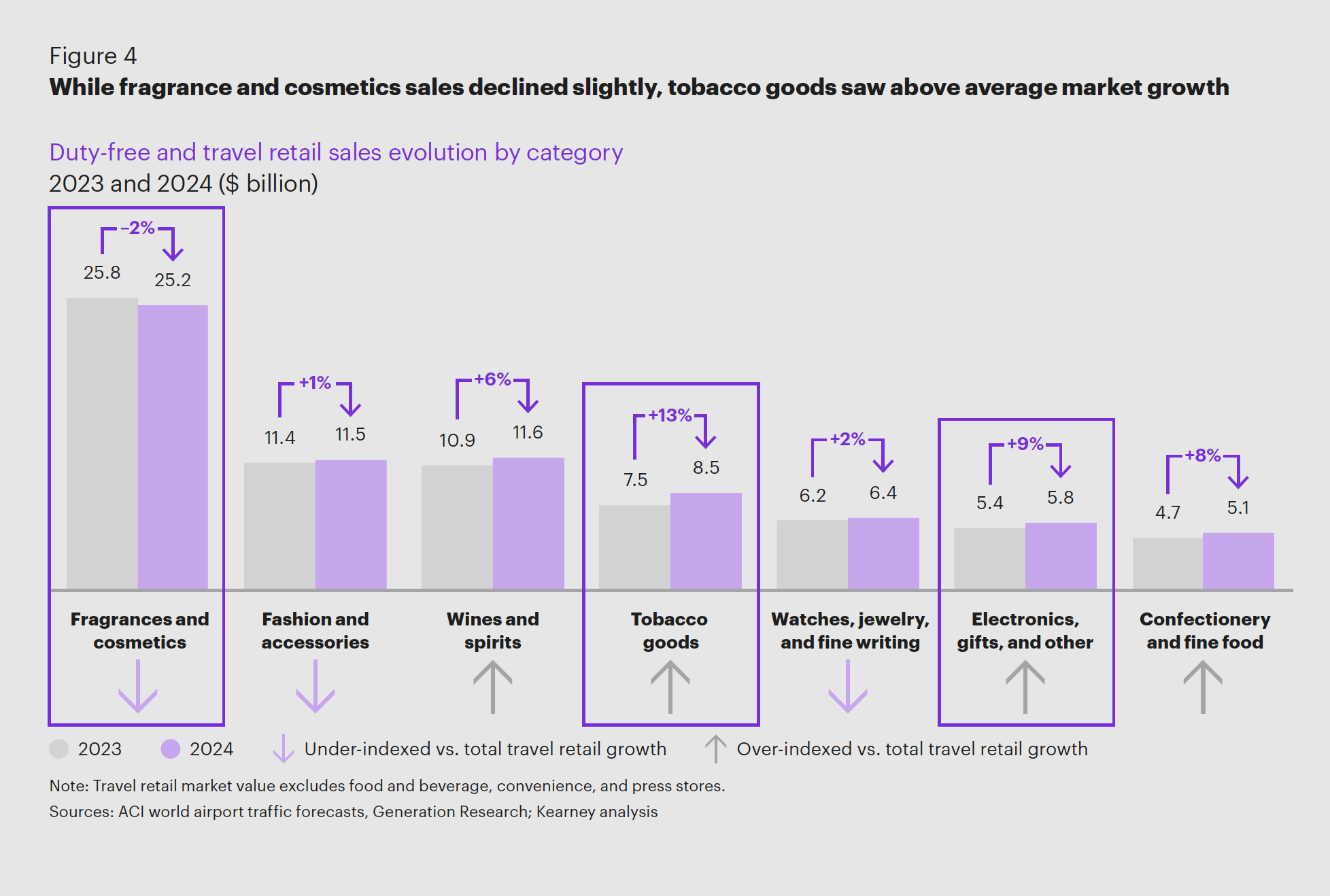September 30, 2025
Travel retail faces widening gap between passenger volumes and sales growth
Travel retail sales reached US$74.1 billion in 2024 despite passenger numbers hitting record highs of 9.5 billion, representing a 13 percent shortfall compared to 2019 levels
Travel retail sales reached US$74.1 billion in 2024 despite passenger numbers hitting record highs of 9.5 billion, representing a 13 percent shortfall compared to 2019 levels. The gap marks the third straight year that sales growth has lagged behind traffic recovery, according to Kearney’s annual industry report released ahead of the TFWA World Exhibition & Conference in Cannes.
The consulting firm’s analysis, which included a global survey of over 3,000 travelers and interviews with more than 40 senior executives, reveals what began as a temporary post-pandemic mismatch has evolved into a structural disconnect between passenger volumes and retail performance.

“People are traveling more again but spending less on average, against a backdrop of slowing consumption from Mainland China and a patchy outlook in North America,” the report states. Strong rebound dynamics in the Middle East and Europe plus India’s growth trajectory have not offset the broader trend.
Geopolitical volatility reshapes routes and spending
The report emphasizes five macro forces applying pressure to the market:deepening geopolitical reordering, geo-economic fragmentation, social polarization, accelerating technology and an atomized climate response. These factors directly affect passenger sentiment, behavior and operational responses.
Between 30 and 40 percent of regional passenger volume in the Middle East and Asia Pacific originates in areas facing higher conflict exposure, with such disruption involving airspace closures and sanctions. This means roughly a quarter of the global travel retail market – more than US$18 billion – sits in areas of acute volatility.
The Russia-Ukraine conflict illustrates how narrowing airspace determines market trends. With East-West traffic diverted as a direct consequence of the conflict, approximately 17 million outbound passengers were lost and only partially offset by alternative routes. Russian high spenders shifted fromEuropean airport hubs to locations in Asia and the Middle East, resulting in a net loss exceeding US$165 million in sales.
The report examines how new trade barriers could affect the market through price simulations. While effects on consumers vary, scenarios exist where domestic retail in the United States passes on tariff costs while duty free pricing doesn’t. For Swiss luxury watch brands, tighter import duties up to 39 percent could create a duty-free price gap exceeding 35 percent.

Kearney’s survey shows 57 percent of respondents claim destination and travel choices will be increasingly influenced by geopolitical tensions. This number rises among Gen Z travelers (64 percent) and exceeds 70 percent withinAsia Pacific. Up to 65 percent of duty free shoppers said political and economic tensions impact which brands they purchase.
Structural decoupling between traffic and spend
Average spend per passenger has fallen since 2020, when it peaked at US$24.30before dropping to US$15.50 in 2024. The spread between traffic growth (8.5 percent) and travel retail value growth (3.0 percent) widened markedly in 2024.
The Asia Pacific region, home to the world’s largest air traffic pool, saw its market decline year-over-year by 2 percent in sales value. Lackluster consumer spending in Mainland China stems from tougher customs checks, stricter controls on daigou operators and improved availability of luxury items in the domestic market. Brands have also reduced promotional activities within regional hubs such as Seoul, Singapore and Hong Kong.
India stands as the outlier, where the market grew 21 percent against a backdrop of major investment in airport upgrades and privatizations plus the rise of an affluent middle class undertaking regular global travel.

Europe’s travel retail market increased 9.2 percent, outstripping the regional rise in passengers (7.7 percent). The Middle East-Africa zone grew 8percent, with new terminal openings and expanded product ranges in liquor and beauty underpinning growth. Dubai International Airport reclaimed its position as the world’s busiest airport in 2024 with 92 million annual passengers.
The Americas saw modest growth at 4 percent, with scattered retail presence in airports limiting potential gains.
Duty-free price promise under question
While 58 percent of travelers surveyed “feel” that airport shopping is cheaper than retail shopping, approximately one in four question whether deals bring real value. Bargain-hunting passengers now have access to price checking applications, while stronger domestic and e-commerce offers exist outside airports.
The mid-tier price range (between US$50 and US$299), historically the dependable heart of travel retail, is thinning as consumers lean toward value items under US$50 or trade up for premium items in the US$300 to US$999 range.
More than 50 percent of survey respondents believe spirits come cheaper in duty free than in their home country, showing this questioning of the price model has category exceptions.
Product differentiation drives conversion
In India, 95 percent of shoppers perceive duty-free prices as more attractive than domestic channels and 83 percent recognize that travel retail’s offering has improved qualitatively. In Saudi Arabia, 63 percent of travelers feel more confident about spending in travel retail than three years ago.

The viral success of Dubai Chocolate since sales began in April 2024 atDubai airport, generating roughly 13 million dirham (US$3.5 million) in just a few days, demonstrates the enduring pull of unique products marketed with exclusivity and connection to place.
European consumers show more skepticism, with less than half of UK travelers believing airport shopping represents a better deal than the high street, 35percent in Germany and only 17 percent feeling confident in their future airport spending in France.
Food and beverage shows positive dynamics, particularly across generational patterns. While duty-free shops and retail concessions saw revenues drop 34percent and 18 percent respectively between 2019 and 2023, food and beverage sales rose 8 percent. Two-thirds of Gen Z travelers surveyed claim they enjoy dining at airports, three times the proportion of baby boomers.
Strategic recommendations
“The latest edition of our travel retail report shows that the industry is faced with an unprecedented range of challenges, namely increasing geo-political disruption with conflict zones and tariffs but also a longer-term erosion of the price promise of duty free,” according to Victor Dijon, partner in Kearney’sZurich office and co-author of the report.
“But it does not have to be the end of value creation for travel retail. On the contrary, it could be the start of a new operating model for the players that adapt shrewdly to this new world in flux.”
Dijon outlines four core capabilities to navigate turbulence: leveraging traveler-flow sensing, in which AI can help retailers anticipate consumer patterns through data on passenger movements within the airport, and enhancing the value proposition through perks, a deep sense of place and immersive experiences embracing digital.
“Pricing and assortment agility through calibrating price floors and ceilings and deploying ESLs (electronic shelf labels) in sales points is crucial for retailers to optimize margins,” he said.
A strategy of adaptive staffing ensures team members speaking multiple languages and sometimes aided by advisor copilots to have the latest sales prompts are in the right place at the right time to convert sales.
“Above all, centralized data sharing and more flexible operational models are at the heart of this structural shift: those players that proactively engage with these commercial, technological and human challenges on a global level could end up being the high flyers of the future travel retail industry.”




